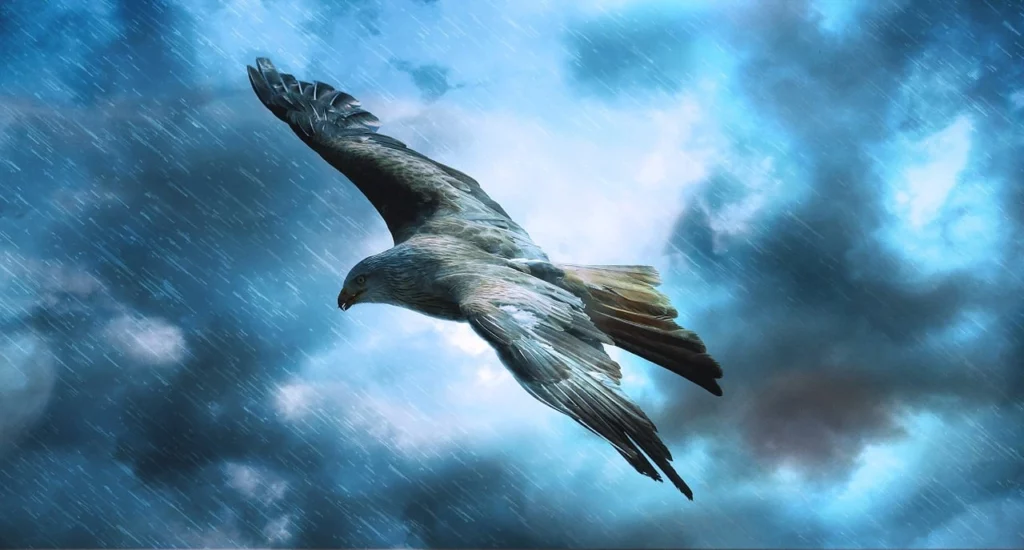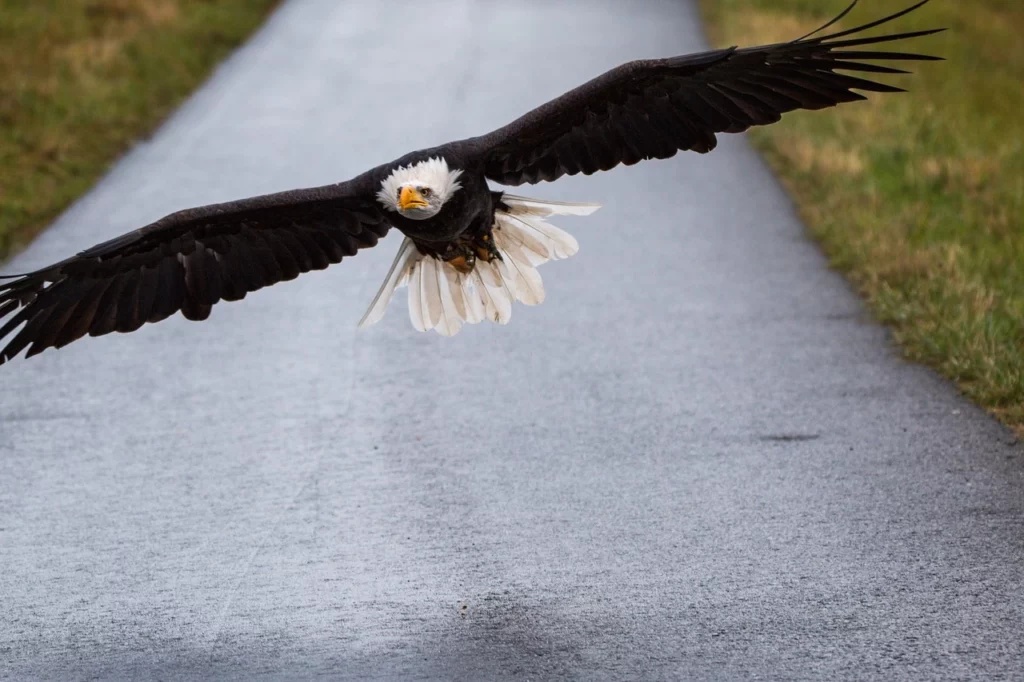As majestic creatures with unrivaled aerial prowess, eagles have captivated the human imagination for centuries. These magnificent birds of prey are renowned for their extraordinary ability to cover vast distances through the air with grace and precision, unlike any other creature. Among the many questions that arise when contemplating the fascinating world of eagles, there’s a common one, “How high do eagles fly?”
Let’s embark on a journey uncovering the great altitudes eagles reach in their quest for survival, dominance, and pursuit of their prey. Join us as we soar alongside these fantastic creatures and witness the heights they reach in their airborne dominion.
How High Do Eagles Fly?
Eagles, the epitome of aerial grace, possess an incredible ability to ascend to remarkable heights. Their flight capabilities are a testament to their mastery of the skies. While various factors, such as species, size, and geographical location, influence their maximum altitude, eagles are known to soar to unimaginable heights.
On average, these majestic birds reach altitudes ranging from 10,000 to 15,000 feet above sea level during normal flight. But in moments of exceptional thermals or updrafts, they ascend even further. Some reports showed that eagles have been observed flying as high as 20,000 feet or more. This remarkable altitude allows them to survey and navigate enormous territories, locate potential prey, and defend their nesting areas with a vantage point that only a few other creatures can rival.
Through their incredible ability to conquer heights, eagles showcase their incomparable command of the sky and inspire awe in those who witness their majestic flights.
Do Eagles Fly Higher Than Other Birds?
When it comes to flying higher than other birds, eagles are indeed among the elite. The altitude at which birds fly can vary depending on species, environment, and purpose. Most eagles have been recorded flying as high as 10,000 feet, some even crossing 20,000 feet above sea level.
While eagles are known for their remarkable ability to fly high, it’s important to note that other birds, such as Rupert’s Griffon vultures which fly at a whopping 37,000 feet, and migratory birds like Bar-headed Geese, display impressive altitudinal feats at 22,000 feet.
Can Eagles Fly During Storms?

Eagles’ exceptional eyesight, acute sensory perception, and powerful wings allow them to anticipate and react to changing weather conditions. Also, their large, strong feathers and agile flight techniques help them adjust their flight patterns, find thermals for lift, and seek out areas of reduced turbulence, so they can safely navigate through storms.
How Does An Eagle Fly So High Considering Its Size?
Eagles fly to incredible heights and remain aloft for long, defying gravity with their seemingly effortless flight. These majestic birds have adapted remarkable strategies to maintain flight at such lofty altitudes despite their size. Two key factors that contribute to their soaring abilities,
Thermal Updrafts
Thermals are warm air that rises from the Earth’s surface because of the heating of the ground by the sun. As the sun’s rays warm the land, the air in contact with it also warms up. This warm air is less dense than the surrounding cooler air, creating an updraft.
Eagles have keen senses that allow them to detect these thermals. They have large lungs, and specially produced hemoglobin that helps the oxygen remain in their blood. By circling within the thermal, the eagle can ride the upward current like an elevator to gain altitude without using much energy. As the eagle reaches the top of the thermal, it then glides to the next one and repeats the process, maintaining flight at higher altitudes for longer periods.
Orographic Updrafts
These are created by the interaction of wind with mountains or other elevated terrain features. As the wind approaches a mountain, it is forced to rise, generating an updraft on the windward side. This upward flow of air provides extra lift for the eagle, so it ascends even higher. By strategically using orographic updrafts, eagles conserve energy while maximizing their altitude and surveying vast territories below.
The combination of thermal and orographic updrafts allows eagles to reach great altitudes and remain airborne for extended periods. These adaptations help them navigate their large territories and play an important role in their hunting strategies. From their high vantage points, eagles spot potential prey with amazing clarity, swooping down and attacking prey with fantastic speed and precision.
How Fast Can Eagles Fly?

With their impressive wingspans and powerful muscles, eagles reach remarkable speeds as they fly through the skies. So, just how fast can these regal birds soar?
While the speed of eagles varies depending on the species, environmental factors, and flight conditions, they generally fly at incredible speeds. Some species of eagles are known to achieve even greater speeds during their high-speed pursuits. For example, the Bald Eagle flies at 120-160 km/h, while Golden Eagles fly at a staggering 320 km/h.
Eagles’ incredible velocity is attributed to not only their physical attributes but also their exceptional flying techniques. They utilize thermal updrafts, or rising columns of warm air, to gain altitude and conserve energy.
How Strong Are Eagles Claws?
Eagles possess exceptionally strong claws, also known as talons, that enable them to capture and grasp their prey with remarkable force. Bald Eagles can grip their talons at 300 psi (pound per square inch).
How Long Can Eagles Fly Without Stopping?
Eagles are known for their extraordinary flight capabilities, effortlessly gliding through the skies with astonishing grace. When it comes to endurance, these majestic birds of prey possess remarkable stamina to fly great distances without the need for rest stops. So, just how long can eagles fly without stopping?
The duration of an eagle’s continuous flight largely depends on several factors, like the species, weather conditions, and purpose of the flight. Eagles are capable of flying for several hours without landing. During migration, some species can cover impressive distances, often spanning hundreds or even thousands of miles, before finally descending to rest and refuel.
The bald eagle, for example, is one of North America’s most iconic avian symbols and is known for its long-distance flights. These mighty birds have been observed flying for up to 6-8 hours without a break during migration. Similarly, with its impressive wingspan and powerful flight, the golden eagle can soar for a long time, occasionally covering over 300 miles in a single day.
While eagles possess remarkable stamina, they eventually need to rest and replenish their energy. After a long flight, they seek suitable perches or nesting sites to recuperate, feed, and regain strength for the next soaring adventure.
FAQs
1. What Bird Can Fly Over Mount Everest?
Ans: The bar-headed goose is known to be capable of flying over Mount Everest and has been observed during its annual migration crossing the towering summit of Mount Everest, which stands at approximately 29,000 feet. Their enlarged lungs and unique blood composition make it easier for them to navigate and survive in the thin air of such extreme altitudes easier for them.
2. Can You Keep An Eagle As A Pet?
Ans: No, keeping an eagle as a pet is generally not feasible or recommended. Eagles are wild birds and require specialized care, large enclosures, and appropriate hunting opportunities to thrive. Also, legal restrictions and permits are often in place to protect these magnificent creatures and preserve their natural habitats.
3. Are Eagles Easily Scared?
Ans: Eagles, although they possess regal and confident demeanor, are usually scared of humans, especially Bald Eagles. They exhibit caution in certain situations and will tolerate moderate disturbances or threats. A nesting pair wants to nest in isolation, but human interference will drive them out.
4. Can Eagles See In The Dark?
Ans: While eagles have exceptional vision, they are not specifically adapted for seeing in complete darkness like some nocturnal animals. But they do have impressive low-light vision. Their large eyes and high concentration of light-sensitive cells help them perceive details and spot prey even in dimly lit conditions.
5. How Long Do Eagles Live?
Ans: Eagles are known for their relatively long lifespans compared to many other bird species. Depending on the species, Bald Eagles live for a good 30-40 years, while Crowned Eagles tap out much early in 14-15 years.
Conclusion
We hope this answers all your questions about eagle flights! Eagles are magnificent aerial creatures capable of soaring to great heights. Their flight patterns depend on species and environmental factors. Still, there’s no doubt that they’re truly some of the most fantastic creatures soaring, showcasing their incredible adaptability and mastery of the skies.

